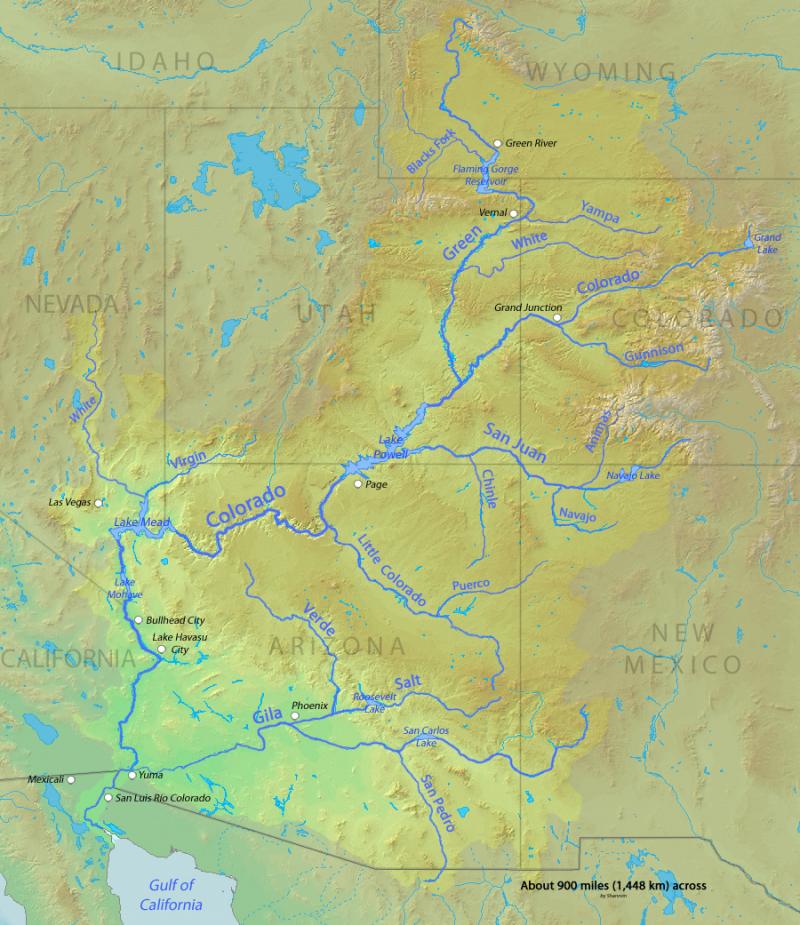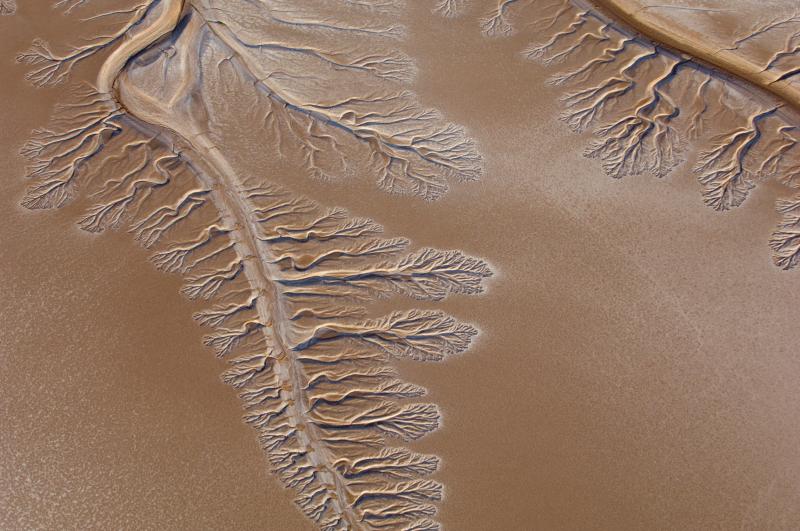
The Colorado River runs 1,450 miles from its headwaters in Colorado to the Gulf of California. Its watershed spans seven U.S. states and two Mexican states, providing vital water to major metropolitan areas in the American Southwest.
The Colorado River runs 1,450 miles from its headwaters in Colorado to the Gulf of California. Its watershed spans seven U.S. states and two Mexican states, providing vital water to major metropolitan areas in the American Southwest.
Map by Shannon using public domain DEMIS and USGS Seamless server, “Colorado River Map”, 25 February 2010.
 This work is licensed under a Creative Commons Public Domain Mark 1.0 License.
This work is licensed under a Creative Commons Public Domain Mark 1.0 License.
In 1922, representatives from seven U.S. Western states met to design the first water allocation of an intrastate river. The Colorado River, with headwaters in the state of Colorado, flows 1,450 miles into Mexico and the Gulf of California, serving as the lifeline to southwestern populations. As such, every state along the river had incentive to reach a water allocation agreement. However, negotiations nearly failed and Arizona did not ratify the compact until 1944. The Colorado River Compact divides the total water of the river (determined from flow records to be 15 million acre feet (MAF) (18.5 billion cubic meters)), between an Upper and Lower Basin. The Upper Basin, consisting of Wyoming, Colorado, New Mexico, and Utah, must deliver 7.5 MAF (9.25 billion cubic meters) each year to the Lower Basin, comprised of Arizona, Nevada, and California, under the compact. This volume-based allocation did not account for the high interannual variability of the river or the varied needs of the river’s stakeholders, whether urban, rural, tribal, agricultural, recreational, or environmental. Though only four pages in length, the compact formed the foundation for an incredibly complex collection of court decisions, statutes, regulations, and other documents known as the “Law of the River.”
External video. Link: https://youtu.be/p-_oAF2hDU4 The Southern Nevada Water Authority made saving water a priority and a cultural value for the Las Vegas metropolitan area with commercials such as “The Neighbor.” (Southern Nevada Water Authority, “The Neighbor,” TV Ads, www.changeyourclock.com).
The Southern Nevada Water Authority made saving water a priority and a cultural value for the Las Vegas metropolitan area with commercials such as “The Neighbor.” (Southern Nevada Water Authority, “The Neighbor,” TV Ads, www.changeyourclock.com).
The “Law’s” premises came under harsh scrutiny in the early 2000s as severe drought plagued the American Southwest. Enter: Patricia Mulroy, head of the Southern Nevada Water Authority in Las Vegas. Mulroy spent most of the 1990s bringing together the metropolis’s vying water districts to better tackle the issues of water supply and scarcity. In 2001, she secured the city’s water banking agreement with Arizona, the first of its kind, in which the city of Las Vegas paid Arizona’s Water Banking Authority to purchase water from Arizona’s farmers and hold it in underground reserves for the city. When that water was needed in future years Las Vegas would take an equivalent portion out of the Lake Mead reservoir and Arizona could tap its stored underground supply. By circumventing prolonged and costly interstate litigation, Mulroy spearheaded an innovative approach that would soon refigure water relationships throughout the entire Colorado River Basin. In 2007, after three years of negotiations, the Lower Basin States reached an agreement in which three trigger points were set—1075, 1050, and 1025 feet above sea level in Lake Mead—that if reached would force graduated curtailments in water use. The agreement also allowed for water efficiency projects and storage in Lake Mead in order to thwart implementation of the water use restrictions. Such cooperation aimed at spreading water scarcity amongst many to lessen the effects for all.
External video. Link: https://youtu.be/G2dpLCkFPRg Patricia Mulroy explains the centrality of the Colorado River to Las Vegas and applauds the city’s residents for their efforts to conserve water. (Southern Nevada Water Authority, “Thanks for Helping”, YouTube snwavideo).
Patricia Mulroy explains the centrality of the Colorado River to Las Vegas and applauds the city’s residents for their efforts to conserve water. (Southern Nevada Water Authority, “Thanks for Helping”, YouTube snwavideo).

Minute 319 allotted water to restore the desiccated Colorado River Delta in Mexico’s Sonoran Desert. Prior, the river ended five miles north of its historic terminus in the Gulf of California, also known as the Sea of Cortez.
Minute 319 allotted water to restore the desiccated Colorado River Delta in Mexico’s Sonoran Desert. Prior, the river ended five miles north of its historic terminus in the Gulf of California, also known as the Sea of Cortez.
Pete McBride, U.S. Geological Survey, “Colorado River Dry Delta”, 12 January 2009.
 This work is licensed under a Creative Commons Public Domain Mark 1.0 License.
This work is licensed under a Creative Commons Public Domain Mark 1.0 License.
Cooperation between metropolitan water districts and states was not the only feat accomplished at the bargaining table, however. Since the 1990s, Mulroy had advocated for the inclusion of Mexico as an equal partner at the water-divvying table, calling the desiccated Colorado River Delta a shame for the entire river community. On 20 November 2012, Mexico joined the U.S. Colorado River community through an agreement known as Minute 319. As the New York Times explained: “[…] the two countries will share in both surpluses and water shortage. During drought years in the United States, less water will be sent to Mexico. In exchange, during years of plenty, Mexico will be allowed to store some of its water north of the border.” The agreement also provided funding measures for improvements to Mexico’s earthquake-damaged water infrastructure as well as water allotments to restore the Colorado River Delta. “The Colorado River, in so many ways, makes us one people,” posited U.S. Secretary of the Interior Ken Salazar at the signing of this agreement, “and together we face the risk of reduced supplies in years ahead.”
External video. Link: https://cdnapisec.kaltura.com/p/1770401/sp/177040100/embedIframeJs/uiconf_id/24976591/partner_id/1770401?iframeembed=true&playerId=kaltura_player&entry_id=0_7ucm8rm8. Patricia Mulroy spoke passionately about working together to face an uncertain future regarding water flows in the Colorado River at the Water Scarcity in the West: Past, Present, Future Conference at the University of California, Davis in April 2015. (CCWAS IGERT Annual Workshop, Water Scarcity in the West: Past, Present, Future, University of California, Davis, April 6–7, 2015).
Patricia Mulroy spoke passionately about working together to face an uncertain future regarding water flows in the Colorado River at the Water Scarcity in the West: Past, Present, Future Conference at the University of California, Davis in April 2015. (CCWAS IGERT Annual Workshop, Water Scarcity in the West: Past, Present, Future, University of California, Davis, April 6-7, 2015).
Secretary Salazar’s sentiment was echoed in a speech given by Patricia Mulroy at the University of California, Davis in April 2015. She implored residents and leaders of the Colorado River Basin to view themselves as “citizens of a watershed,” explaining that “the answers for tomorrow are not new permanent agreements. They are establishing processes whereby as conditions change, we who have spent a lifetime warring with one another, can find common answers to the problems on the ground as they occur.” Members of any watershed would do well to heed such words of wisdom.
How to cite
Roberts, Stacy N., and Foster, Lauren. “’Citizens of a Watershed’: The Colorado River Compact and the Exigencies of Drought.” Environment & Society Portal, Arcadia (Spring 2016), no. 1. Rachel Carson Center for Environment and Society. https://doi.org/10.5282/rcc/7403.
ISSN 2199-3408
Environment & Society Portal, Arcadia
 This work is licensed under a Creative Commons Attribution-NonCommercial-ShareAlike 4.0 International License.
This work is licensed under a Creative Commons Attribution-NonCommercial-ShareAlike 4.0 International License.
2016 Stacy N. Roberts and Lauren Foster
This refers only to the text and does not include any image rights.
Please click on an image to view its individual rights status.
- “Third Amended and Restated Agreement for Interstate Water Banking among The Arizona Water Banking Authority and The Southern Nevada Water Authority and The Colorado River Commission of Nevada.”. Accessed 20 April 2015.
- Adler, Robert W. “Revisiting the Colorado River Compact: Time for a Change?” Journal of Land, Resources, and Environmental Law (2008).
- Lovett, Ian. “U.S. and Mexico Sign a Deal on Sharing the Colorado River.” New York Times, 20 November 2012. Accessed 20 April 2015.
- Nies, Judith. Unreal City: Las Vegas, Black Mesa, and The Fate of the West. New York: Nation Books, 2014.
- Rothman, Hal K. Playing the Odds: Las Vegas and the Modern West. Edited by Lincoln Bramwell. Albuquerque: University of New Mexico Press, 2007.
- Summitt, April R. Contested Waters: An Environmental History of the Colorado River. Boulder, CO: University of Colorado Press, 2013.
- United States Congress. “Colorado River Compact, 1922.” Statutes at Large, Chapter 42, 19 August 1921: 171.









